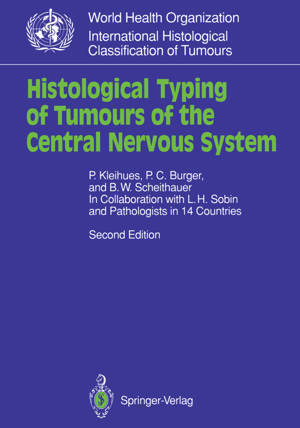
- Afhalen na 1 uur in een winkel met voorraad
- Gratis thuislevering in België vanaf € 30
- Ruim aanbod met 7 miljoen producten
- Afhalen na 1 uur in een winkel met voorraad
- Gratis thuislevering in België vanaf € 30
- Ruim aanbod met 7 miljoen producten
Zoeken
Histological Typing of Tumours of the Central Nervous System
Paul Kleihues, P C Burger, B W Scheithauer
€ 105,45
+ 210 punten
Omschrijving
Although more than 12 years have passed since publication of the first WHO histological classification of central nervous system (CNS) tumours, the changes in this revised edition are not radical. Only one formerly recognized entity has been deleted: the monstrocellular sarcoma, because there is immuno- cytochemical evidence of its astrocytic nature. Several new tumour types have been added: the pleomorphic xanthoastro- cytoma has been generally acknowledged for almost a decade; the neurocytoma has gradually evolved as a clinical-pathological entity; and two new entries, the dysembryoplastic neuroepi- thelial tumour and the desmoplastic infantile ganglioglioma, have only been characterized morphologically during the past few years. We regard the classification as an international standard to facilitate communication and have tried to avoid current con- ceptual controversies. The majority of partiCipants supported inclusion of the term "primitive neuroectodermal tumour" (pNET). However, because of our limited knowledge of the biol- ogy of embryonal CNS tumours, preference was given to use PNET selectively, rather than applying it to all small cell embryo- nal childhood tumours, irrespective of their histological pheno- type. Ependymomas and meningiomas now have new histological SUbtypes. Most of these are not associated with biological behaviour different from the parent tumour type, but their description will aid the practising pathologist to identify and classify these lesions. 2 Introduction Histological Typing Following the philosophy of this WHO series, classification is based primarily on histological assessment of cell types and tis- sue patterns recognized by conventional light microscopy.
Specificaties
Betrokkenen
- Auteur(s):
- Uitgeverij:
Inhoud
- Aantal bladzijden:
- 114
- Taal:
- Engels
- Reeks:
Eigenschappen
- Productcode (EAN):
- 9783540569718
- Verschijningsdatum:
- 30/07/1993
- Uitvoering:
- Paperback
- Formaat:
- Trade paperback (VS)
- Afmetingen:
- 170 mm x 244 mm
- Gewicht:
- 222 g

Alleen bij Standaard Boekhandel
+ 210 punten op je klantenkaart van Standaard Boekhandel
Beoordelingen
We publiceren alleen reviews die voldoen aan de voorwaarden voor reviews. Bekijk onze voorwaarden voor reviews.











